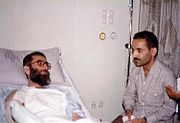
Mohammad Ali Rajai
Encyclopedia
Mohammad Ali Rajai was the second elected President
of Iran
from 2 to 30 August 1981, after serving as Prime Minister
under Abolhassan Banisadr
. He was also Minister of Foreign Affairs
from 11 March 1981 to 15 August 1981, while he was Prime Minister. He was assassinated in a bombing on 30 August 1981, along with prime minister Mohammad Javad Bahonar
.
 Mohammad-Ali Rajai was born on 15 June 1933 in Qazvin, Iran. His father, Abdulsamad, died when Mohammad-Ali was only 4 years old, after which he lived with his mother and brother.
Mohammad-Ali Rajai was born on 15 June 1933 in Qazvin, Iran. His father, Abdulsamad, died when Mohammad-Ali was only 4 years old, after which he lived with his mother and brother.
Rajai grew up in Qazvin, and moved to Tehran in 1946. After moving to Tehran, he had a close relationship with the anti-Shah groups and parties. He known with Ayatollah Mahmoud Taleghani
. In 1958, He moved to Bijar
for a short period, but after a year, he moved back to Tehran and graduated with a degree in Education from Tarbiat Moallem University
in 1959.http://reshteha.roshd.ir/university/emkanat.aspx?uid={c48be5d8-3bc6-4194-a4f0-3432a30467be}&choice=2
He was arrested by the Shah's government in May 1974, but was set free after four years.
He was actively involved in the Iranian Revolution
and was a leader in the movement to purge Iranian universities of American and European influences, which was later called the Cultural Revolution.
, he became Minister of Education in the government of Mehdi Bazargan
, and although Bazargan's Cabinet resigned in 6 November 1979, Rajai did not resign and remained a minister until 12 August 1980, when he became prime minister. When Bani Sadr became the president of Iran in the first presidential election, he had to nominate a new prime minister, and after 5 months, he nominated Rajai for the position, and parliament voted him in. He appointed Khodapanahi as Foreign Minister, Mohammad-Reza Mahdavi Kani as Interior Minister and Javad Fakori
as Defence Minister. During his prime ministership, Iran-Iraq War
was started and his government's first policy became the "victory and defense". He was in office until 2 August 1981, when he became the second president of Iran.
in 1981. He became the second president and the first president from the Islamic Republican Party
after winning 91% of the votes. He officially became the president after Oath of Office in 2 August 1981. He named Mohammad-Javad Bahonar to the Parliament to become the next prime minister. Parliament voted in to Bahonar and he formed a new government.
. Witnesses later stated that a trusted aide brought a briefcase into the conference room, set it between the two leaders, and then left. Another person opened the case, triggering a bomb that set the room ablaze and killed Rajai, Bahonar, and three others. The assassin was identified as Massoud Kashmiri, an operative of the People's Mujahedin of Iran (also known as the MKO, MEK and PMOI), who had infiltrated the Prime Minister's office in the guise of a state security official. Rajai was buried in Behesht-e Zahra
.
President of Iran
The President of Iran is the highest popularly elected official in, and the head of government of the Islamic Republic of Iran; although subordinate to the Supreme Leader of Iran, who functions as the country's head of state...
of Iran
Iran
Iran , officially the Islamic Republic of Iran , is a country in Southern and Western Asia. The name "Iran" has been in use natively since the Sassanian era and came into use internationally in 1935, before which the country was known to the Western world as Persia...
from 2 to 30 August 1981, after serving as Prime Minister
Prime Minister of Iran
Prime Minister of Iran was a political post in Iran that had existed during several different periods of time starting with the Qajar era until its most recent revival from 1979 to 1989 following the Iranian Revolution.-Prime Ministers of Qajar era:In the Qajar era, prime ministers were known by...
under Abolhassan Banisadr
Abolhassan Banisadr
Abulhassan Banisadr is an Iranian politician, economist and human rights activist who served as the first President of Iran from 4 February 1980 after the 1979 Iranian Revolution and the abolition of the monarchy until his impeachment on 21 June 1981 by the Parliament of Iran...
. He was also Minister of Foreign Affairs
Minister of Foreign Affairs (Iran)
The Ministry of Foreign Affairs is an Iranian government ministry. The Minister for Foreign Affairs is the Cabinet member in charge....
from 11 March 1981 to 15 August 1981, while he was Prime Minister. He was assassinated in a bombing on 30 August 1981, along with prime minister Mohammad Javad Bahonar
Mohammad Javad Bahonar
Hojatoleslam Mohammad Javad Bahonar was an Iranian scholar, Shiite theologian and politician who served as the Prime minister of Iran from 15 to 30 August 1981 when he was assassinated by Mujahideen-e Khalq MEK, also known as PMOI and KMO...
.
Early life and career

Rajai grew up in Qazvin, and moved to Tehran in 1946. After moving to Tehran, he had a close relationship with the anti-Shah groups and parties. He known with Ayatollah Mahmoud Taleghani
Mahmoud Taleghani
Ayatollah Mahmoud Taleghani was an Iranian theologian, humanist, Muslim reformer, democracy advocate and a senior Shi'a cleric of Iran. Taleghani was a contemporary of the Iranian Revolutionary leader Ayatollah Ruhollah Khomeini and a leader in his own right of Iran's Shi'a resistance movement...
. In 1958, He moved to Bijar
Bijar
Bijar is a city is a city in and capital of Bijar County, Kurdistan Province, Iran. At the 2006 census, its population was 46,156, in 12,312 families...
for a short period, but after a year, he moved back to Tehran and graduated with a degree in Education from Tarbiat Moallem University
Tarbiat Moallem University
Tarbiat Moalem University , also known as Kharazmi University , is a major university in Tehran, Iran, offering undergraduate and postgraduate studies...
in 1959.http://reshteha.roshd.ir/university/emkanat.aspx?uid={c48be5d8-3bc6-4194-a4f0-3432a30467be}&choice=2
He was arrested by the Shah's government in May 1974, but was set free after four years.
He was actively involved in the Iranian Revolution
Iranian Revolution
The Iranian Revolution refers to events involving the overthrow of Iran's monarchy under Shah Mohammad Reza Pahlavi and its replacement with an Islamic republic under Ayatollah Ruhollah Khomeini, the leader of the...
and was a leader in the movement to purge Iranian universities of American and European influences, which was later called the Cultural Revolution.
Ministerial posts
After the Iranian RevolutionIranian Revolution
The Iranian Revolution refers to events involving the overthrow of Iran's monarchy under Shah Mohammad Reza Pahlavi and its replacement with an Islamic republic under Ayatollah Ruhollah Khomeini, the leader of the...
, he became Minister of Education in the government of Mehdi Bazargan
Mehdi Bazargan
Mehdi Bazargan was a prominent Iranian scholar, academic, long-time pro-democracy activist and head of Iran's interim government, making him Iran's first prime minister after the Iranian Revolution of 1979. He was the head of the first engineering department of Tehran University...
, and although Bazargan's Cabinet resigned in 6 November 1979, Rajai did not resign and remained a minister until 12 August 1980, when he became prime minister. When Bani Sadr became the president of Iran in the first presidential election, he had to nominate a new prime minister, and after 5 months, he nominated Rajai for the position, and parliament voted him in. He appointed Khodapanahi as Foreign Minister, Mohammad-Reza Mahdavi Kani as Interior Minister and Javad Fakori
Javad Fakori
Major General Javad Fakoori was a Islamic Republic of Iran Air Force leader. He was the commander of the IRIAF during the Iran–Iraq War and served as Defense Minister. He was killed in an air crash. When he died he held the rank of Major General....
as Defence Minister. During his prime ministership, Iran-Iraq War
Iran-Iraq War
The Iran–Iraq War was an armed conflict between the armed forces of Iraq and Iran, lasting from September 1980 to August 1988, making it the longest conventional war of the twentieth century...
was started and his government's first policy became the "victory and defense". He was in office until 2 August 1981, when he became the second president of Iran.
Presidency
Banisadr was impeached on 22 June 1981 by parliament, and Khomeini held a Provisional Presidential Council by 6 people headed by Mohammad Beheshti and later Abdul-Karim Mousavi Ardebili. Rajai was one of the members of that Council. He nominated himself for the presidential electionIranian presidential election, July 1981
The Iranian presidential election of July 1981 took place on July 24, 1981 after the previous Iranian president, Abolhassan Banisadr, was impeached by the Majlis on June 21 and then sacked by the Supreme Leader, Ayatollah Khomeini, on June 22...
in 1981. He became the second president and the first president from the Islamic Republican Party
Islamic Republican party
The Islamic Republican Party was a political party in Iran, formed in mid-1979 to assist the Iranian Revolution and Ayatollah Khomeini establish theocracy in Iran...
after winning 91% of the votes. He officially became the president after Oath of Office in 2 August 1981. He named Mohammad-Javad Bahonar to the Parliament to become the next prime minister. Parliament voted in to Bahonar and he formed a new government.
Assassination
On 30 August 1981, President Rajai held a meeting of Iran's Supreme Defense Council, along with the Prime Minister Mohammad Javad BahonarMohammad Javad Bahonar
Hojatoleslam Mohammad Javad Bahonar was an Iranian scholar, Shiite theologian and politician who served as the Prime minister of Iran from 15 to 30 August 1981 when he was assassinated by Mujahideen-e Khalq MEK, also known as PMOI and KMO...
. Witnesses later stated that a trusted aide brought a briefcase into the conference room, set it between the two leaders, and then left. Another person opened the case, triggering a bomb that set the room ablaze and killed Rajai, Bahonar, and three others. The assassin was identified as Massoud Kashmiri, an operative of the People's Mujahedin of Iran (also known as the MKO, MEK and PMOI), who had infiltrated the Prime Minister's office in the guise of a state security official. Rajai was buried in Behesht-e Zahra
Behesht-e Zahra
Behesht-e Zahra , is the largest cemetery in Iran. Located in the southern part of metropolitan Tehran, it is connected to the city by a metro line. The cemetery has been one of the inspirations for the popular webcomic, Zahra's Paradise.-History:...
.

